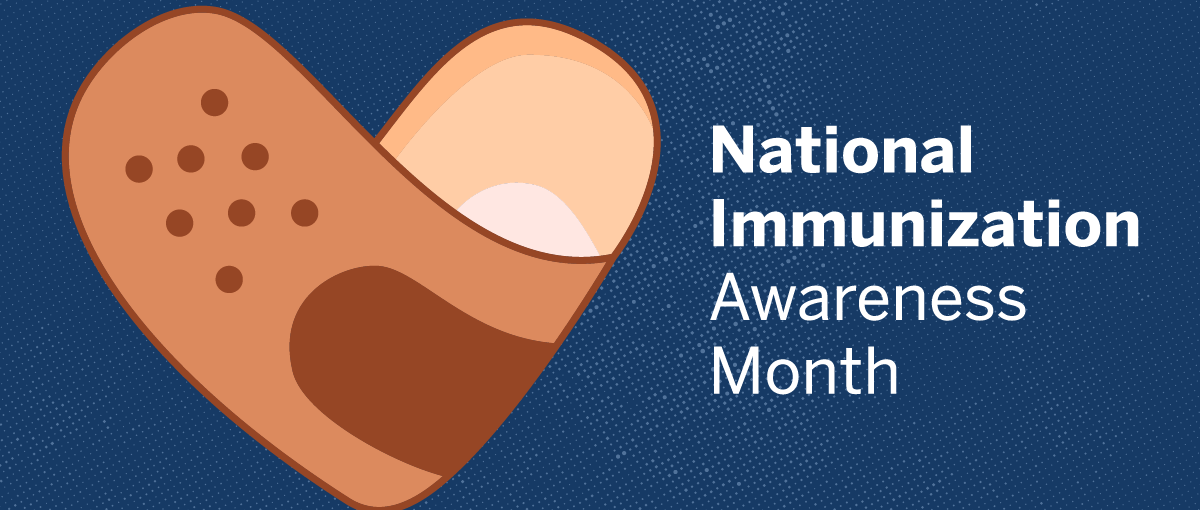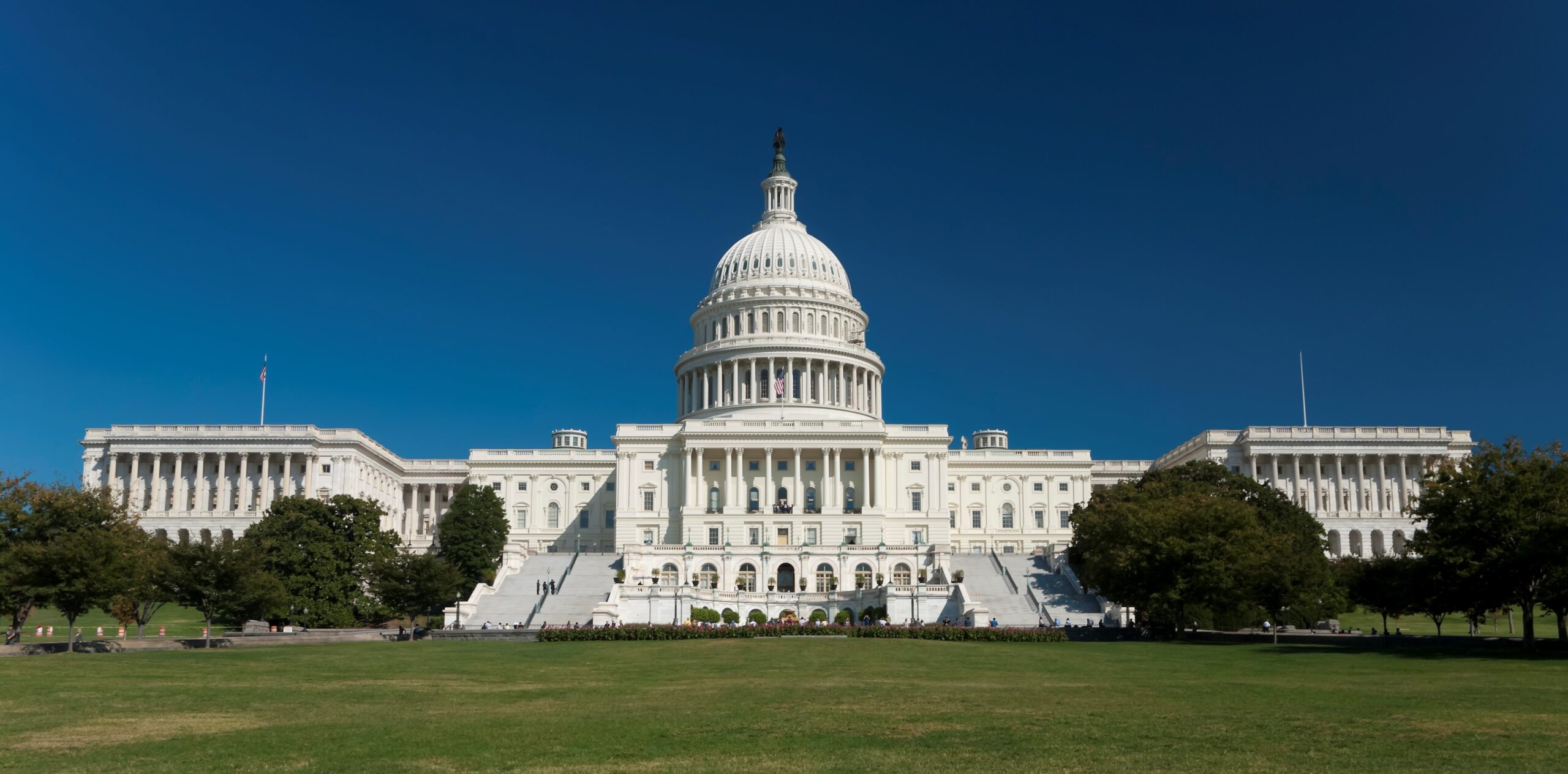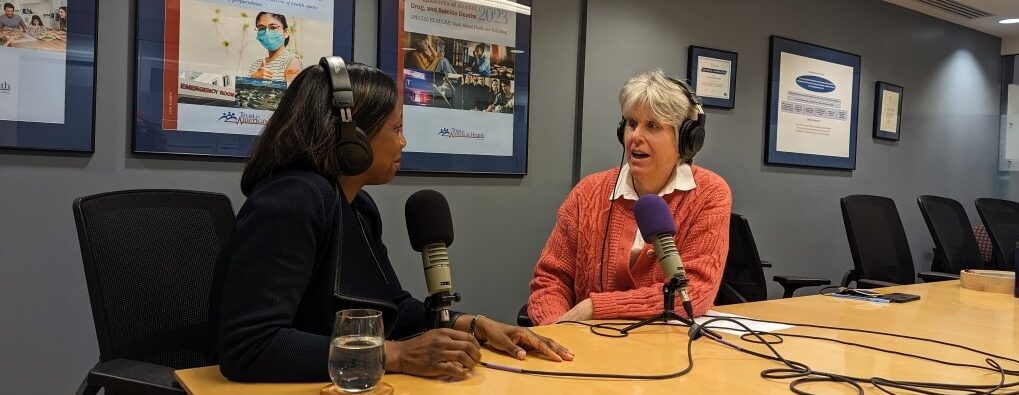Issue Category: Obesity/Chronic Disease
National Immunization Month Highlights Lifesaving Benefits of Vaccines
August 2024
National Immunization Awareness Month sponsored by the National Public Health Information Coalition (NPHIC) and observed every August, highlights the lifesaving benefits of vaccines. During the month, activities will raise awareness of the importance of vaccinating people of all ages against serious and sometimes deadly diseases. The awareness month also celebrates the successes of immunizations and educates Americans about vaccine safety and effectiveness.
According to a study by the Commonwealth Fund, from December 2020 through November 2022, COVID-19 vaccines prevented approximately 18.5 million hospitalizations and 3.2 million deaths in the U.S., but the lifesaving impact of vaccines extends far beyond COVID-19. Vaccines have dramatically reduced the spread of diseases like measles, polio, and whooping cough, protecting countless individuals and communities.
According to new data published this month by the CDC, among children born during 1994-2023, routine childhood vaccinations will have prevented about 508 million cases of illness, 32 million hospitalizations, and 1,129,000 deaths over the course of their lifetimes.
Unfortunately, numerous factors have led to a decline in vaccination rates in recent years including healthcare disruptions during the COVID-19 pandemic and the spread of misinformation about vaccine safety and effectiveness. In some cases, this has resulted in outbreaks of once-controlled diseases, including measles and to a lesser degree polio, jeopardizing the progress we have made.
According to the American Association of Immunologists, getting vaccinated protects against the spread of infectious diseases by helping our immune systems fight infection. Vaccines work by introducing a weakened or inactive form of a virus or bacteria to the body. This triggers the immune system to develop antibodies, creating a kind of shield against future infection. When a large portion of the population is vaccinated, it creates “herd” or community-level immunity, making it difficult for diseases to spread, even protecting those who haven’t been vaccinated themselves.
The public health benefits of vaccines include:
Disease Prevention: Vaccines are highly effective at preventing serious illnesses like measles, mumps, rubella, polio, diphtheria, tetanus, whooping cough, chickenpox, shingles, influenza, and pneumonia. These diseases can cause severe complications, hospitalization, and even death.
Reduced Healthcare Costs: Vaccines are a cost-effective way to prevent illness and its associated medical expenses. Vaccination programs save billions of dollars in healthcare costs each year.
Protection for Populations at Higher Risk: Vaccines are especially important for protecting those with developing immune systems (infants) or weakened immune systems, such as older adults and people with certain chronic illnesses.
Global Health Impact: Vaccination programs have had a significant impact on global health. They have helped to virtually eliminate smallpox and dramatically reduced the burden of other diseases worldwide.
To build on and sustain the health benefits of vaccines, TFAH’s 2024 Ready or Not: Protecting the Public’s Health from Diseases, Disasters, and Bioterrorism report includes a number of important recommended policy actions to strengthen the nation’s vaccine infrastructure:
- Increased Funding: Congress should provide at least $1.1 billion per year to support vaccine infrastructure and delivery, including programs promoting equitable vaccine distribution.
- Insurance Coverage: Congress and states should ensure first-dollar coverage for recommended vaccines under commercial insurance and for uninsured populations.
- Minimizing Exemptions: States should minimize vaccine exemptions for schoolchildren, and healthcare facilities should increase vaccination rates of healthcare workers.
- New Vaccine Development: Congress should create incentives for new-product discovery to prevent and fight resistant infections including therapeutics, diagnostics, and prevention products such as vaccines.
- Strengthening Influenza Defenses: Congress should strengthen the pipeline of influenza vaccines, diagnostics, and therapeutics.
- Countering Vaccine Misinformation:The spread of misinformation about vaccines can lead to vaccine hesitancy and lower vaccination rates. TFAH calls for promoting accurate information from trusted sources to increase vaccine confidence.
According to research published in The Lancet, since 1974, vaccination has prevented 154 million deaths worldwide. By ensuring equitable access to vaccines, promoting accurate information, and investing in research and education, we can continue to harness the power of vaccines and build a healthier future for all.
What If Congress Adequately Funded Public Health?
You know the old adage, ‘those that don’t learn from history are doomed to repeat it.’ Coming off the COVID-19 public health emergency that has thus far claimed the lives of 1.2 million Americans, there are discussions in Congress to significantly cut funding for public health initiatives to dangerously low levels – again. And it doesn’t have to be like this.
Why do we go through these bleak cycles when anchoring public health in policymaking is a win-win decision for everyone – from elected officials to individual constituents.
Federal public health funding is facing challenges on multiple fronts right now. Congress continues to negotiate appropriations bills for the 2024 fiscal year, which will have major implications for the next fiscal year and beyond. The current short-term funding agreement for Health and Human Services expires on March 22. If Congress passes another continuing resolution rather than new appropriations, it could trigger extreme, across-the-board cuts to non-defense spending.
First, continuing resolutions, which are short-term measures to fund the government at the previous year’s levels, negatively impact the systems we need to protect the nation’s health. And severe cuts triggered by failing to pass a long-term spending bill would be even more dangerous. TFAH has joined more 1,000 other organizations in urging Congress to pass a full-year funding bill using the bipartisan framework laid out in the Senate as a starting point for negotiations.
Secondly, the FY2024 bills proposed by the House and Senate for Labor, Health and Human Services, Education and Related Agencies – the main funding source for public health programs – are vastly different and neither addresses the chronic underfunding of public health. Congress has already rescinded hundreds of millions of dollars intended to shore up the public health workforce and readiness and response efforts. The Senate’s bill proposes a small cut to the Centers for Disease Control and Prevention (CDC), and the House version would cut about $1.6 billion from CDC’s budget. TFAH and partners have called for a $2.5 billion increase for CDC.
Finally, we continue to see proposals to cut the Prevention and Public Health Fund, a critical investment in programs ranging from immunizations to tobacco use prevention. If these proposals were to move forward, this would again push public health funding into the “bust” phase of a decades long “boom and bust” funding pattern.
The health, safety, and well-being of individuals and communities should be at the foundation of U.S. policy and be funded accordingly.
Imagine if we fully invested in the prevention of adverse childhood experiences, suicide, and substance misuse. Many communities would see suicide and overdose rates fall.
Imagine if we prevented the root causes of death, injury, and excess healthcare costs instead of spending trillions of dollars to treat preventable chronic conditions. Workers would be healthier and more productive, employers would face fewer financial burdens, and the nation would be more resilient and thriving.
Imagine if CDC, state, local, tribal, and territorial health departments had modern data systems instead of rudimentary spreadsheets to track the spread of diseases. This country could contain potential outbreaks in their earliest stages and save lives.
Much of our health and well-being is determined by economic, environmental, and societal factors. In the midst of a recent and troubling decrease in life expectancy, TFAH believes that investing in the foundations of public health and effective prevention programs is a critical and indispensable path forward to protecting and promoting the health of the nation.
TFAH Comment Letter to FDA on Reducing Added Sugar Intake (January 2024)
TFAH’s President and CEO Dr. Gracia Discusses the Significance of Dr. Martin Luther King Jr. Day & National Day of Racial Healing
(Washington, DC – January 15, 2024) – This week TFAH’s President and CEO, Dr. J. Nadine Gracia and Director of Strategic Communications and Policy Research Rhea Farberman discussed the significance of two important observances, Dr. Martin Luther King Jr. Day and the National Day of Racial Healing. The conversation focused on the intersections between Dr. King’s mission to advance social justice and TFAH’s work to promote optimal health. Also discussed were the ways in which structural racism creates barriers to good health for many people of color and the policy actions needed to dismantle those barriers.
“What we know, especially in thinking about this in terms of Dr. Martin Luther King, Jr. Day and the National Day of Racial Healing, is that for too many people of color and communities of color there has been, over many decades, a disadvantage in terms of access to health promoting resources.”
“We have to act with a sense of urgency because the health, well-being and prosperity of our nation depends on it. That’s the call that I believe Dr. King would challenge us to continue, to strive for and not relent. That’s his legacy to us, to ensure that everyone us the opportunity to reach their full potential for health.”
Dr. J. Nadine Gracia
President and CEO
Trust for America’s Health
“Listen to the full conversation”
Nutrition Support Programs are Vital to Preventing Food and Nutrition Insecurity and Reducing Chronic Disease – Congress Must Act to Support Them
As of early November 2023, draft appropriation bills by both the House of Representatives and the Senate do not adequately fund the WIC nutrition support program, threatening to break a nearly 30-year, bipartisan commitment to ensure all participants can access the program without waitlists.
(Washington, DC – 11/20/23) – Access to nutritious food is critical to preventing many chronic diseases and is particularly important to keep young children on track with their growth and developmental needs. In 2022, an estimated 12.8 percent of U.S. households experienced food and or nutrition insecurity sometime during the year.
As Trust for America’s Health’s (TFAH) State of Obesity report series has demonstrated, food insecurity is a risk factor for obesity and other nutrition-related chronic diseases. Progress on addressing these critical public health issues is in jeopardy if Congress does not provide funding for federal nutrition support programs during the current fiscal year.
One of the key federal nutrition programs supporting the specific nutritional needs of young children, infants, and birthing people is the Special Supplemental Nutrition Program for Women, Infants, and Children, or WIC. Created in 1972, the WIC program is a short-term, public health intervention program designed to strengthen lifetime nutrition and health behaviors within households with low-incomes. The WIC program provides nutrition benefits tailored to support a young child’s development. Over time, the program, including its food packages, has aligned with new science about the key nutrients infants and children need. These changes have had a significant impact. Studies show that the 2007 benefit update helped improve beneficiaries’ diets and decreased rates of obesity among enrolled toddlers ages 2-4.
The WIC program also adapted to challenges created by the COVID-19 pandemic by implementing new flexibilities, such as allowing WIC agencies to remotely load benefits cards. In 2021, Congress also increased the monthly benefit available to families to purchase more fruits and vegetables from $9 to $26 for children, and from $11 to $47 for pregnant and postpartum participants. These changes modernized the program and in turn increased participation; important because WIC has long had lower participation rates in comparison to the number of eligible families.
Today, nearly seven million parents and children under five years old depend on the WIC program, and participation is expected to grow due to increased program flexibilities. To keep up with increased demand, additional program funding is needed. As of early November 2023, draft appropriation bills by both the House of Representatives and the Senate do not adequately fund the WIC program, which threatens to break a nearly 30-year, bipartisan commitment to ensure all participants can access WIC without waitlists. Increasing food costs, make action to grow the WIC program critically important as families are struggling to afford healthy meals and may be forced to turn to cheaper but less nutritious alternatives.
Critical public health programs like WIC not only provide nutritious foods to families in the short term, but also help prevent diet-related diseases. Trust for America’s Health urges Congress to increase funding in the Fiscal Year (FY) 2024 budget for the WIC program to ensure pregnant and postpartum birthing people and their young children have the nutrition they need to enjoy good
The State of Obesity: Creating Pathways to a Healthier America
On October 11, 2023, Trust for America’s Health hosted an in-person and livestream event recognizing the 20th anniversary of its State of Obesity: Better Policies for a Healthier America report at the National Press Club in Washington, D.C. The two-hour event featured White House and federal officials discussing the Biden Administration’s priorities for improving nutrition and health including its National Strategy on Hunger, Nutrition, and Health. In addition, senior federal agency officials discussed a whole-of-government approach to advance transformative policies and programs designed to address increasing rates of diet-related diseases and improve the health of the nation.
Another highlight of the event was a panel featuring community leaders and medical experts discussing effective community level obesity prevention programs and innovative approaches to create sustainable change to promote health.
Four-time track and field Olympian and American record holder Chaunte Lowe closed the program discussing the role that sports can play in promoting health and well-being. Ms. Lowe is a member of the President’s Council on Sports, Fitness, and Nutrition.
The State of Obesity: Creating Pathways to a Healthier America Livestream Event
(Washington, DC – October 18, 2023) – On October 11, 2023, Trust for America’s Health hosted an in-person and livestream event recognizing the 20th anniversary of its State of Obesity: Better Policies for a Healthier America report at the National Press Club in Washington, D.C. The two-hour event featured White House and federal officials discussing the Biden Administration’s priorities for improving nutrition and health including its National Strategy on Hunger, Nutrition, and Health. In addition, senior federal agency officials discussed a whole-of-government approach to advance transformative policies and programs designed to address increasing rates of diet-related diseases and improve the health of the nation.
Another highlight of the event was a panel featuring community leaders and medical experts discussing effective community level obesity prevention programs and innovative approaches to create sustainable change to promote health.
Four-time track and field Olympian and American record holder Chaunte Lowe closed the program discussing the role that sports can play in promoting health and well-being. Ms. Lowe is a member of the President’s Council on Sports, Fitness, and Nutrition.
Event speakers were:
- Will McIntee, Senior Advisor for Public Engagement, The White House
- James “Jim” Jones, Deputy Commissioner for Human Foods, U.S. Food and Drug Administration (FDA)
- Caree Cotwright, PhD, RDN, Director of Nutrition Security and Health Equity, U.S. Department of Agriculture (USDA)
- Ruth Petersen, M.D., MPH, Director, Division of Nutrition, Physical Activity, and Obesity (DNPAO), Centers for Disease Control and Prevention (CDC)
- Jamila Freightman, CDC High Obesity Program Manager, Louisiana State University AgCenter Healthy Communities Program School of Nutrition and Food Sciences
- Randy Williams, Co-Founder/Vice President of the Robinson/Williams Restoration of Hope Community Center, Bastrop, Louisiana
- Kofi Essel, M.D., MPH, FAAP, Food as Medicine Program Director, Elevance Health
- Chaunte Lowe, 4-time Olympian, American Record Holder, and Council Member, President’s Council on Sports, Fitness, and Nutrition
TFAH President and CEO Dr. J. Nadine Gracia and TFAH Executive Vice President Dr. Tekisha Dwan Everette moderated the event. TFAH Chief Operating Officer Stacy Molander served as the event emcee.
Nuevo informe: Las tasas de obesidad en adultos continua en aumentando, particularmente en comunidades que enfrentan dificultades para lograr una alimentación saludable y tienen menos oportunidades para realizar actividad física
El vigésimo informe anual revela que 22 estados presentan niveles de obesidad en adultos superiores al 35 por ciento
(Washington, DC – 21 de septiembre del 2023) – Según el nuevo informe, publicado el día de hoy sobre el Estado de la obesidad 2023: Mejores políticas para una América más saludable (State of Obesity 2023: Better Policies for a Healthier America), demuestra que la cantidad de adultos en los Estados Unidos con obesidad sigue aumentando. Dicho informe es la vigésima edición anual producida por Trust for America’s Health (TFAH), el cual examina las causas fundamentales del aumento de las tasas de obesidad en el país y hace recomendaciones de políticas para abordarlas.
De acuerdo con el análisis de TFAH de los datos más recientes del Centros para el Control y la Prevención de Enfermedades (CDC, por sus siglas en inglés) y del Sistema de Vigilancia de Factores de Riesgo del Comportamiento, en el 2022, 22 estados tenían una tasa de obesidad en adultos igual o superior al 35 por ciento, en comparación a 19 estados registrados el año anterior. Hace una década atrás, no se registraba una tasa de obesidad igual o superior del 35 por ciento en ningún estado.
Virginia Occidental (41%), Luisiana (40,1%), Oklahoma (40,0%) y Mississippi (39,5%) tienen las tasas más altas de obesidad en adultos. El Distrito de Columbia (24,3%), Colorado (25,0%) y Hawaii (25,9%) tienen las tasas más bajas de obesidad en adultos.
En las últimas dos décadas, las tasas de obesidad han aumentado en todos los grupos de población, y ciertas poblaciones de color experimentan las tasas más altas, a menudo debido a dificultades de estructura referente a una alimentación saludable y a la falta de oportunidades y lugares para estar físicamente activo.
Los resultados de la data en el informe de la Encuesta Nacional de Examen de Salud y Nutrición (NHANES) 2017-2020 rastrean las tendencias de la obesidad a nivel nacional y dentro de los grupos de población. A nivel nacional, el 41,9 por ciento de los adultos tienen obesidad. Los adultos negros, latinos y las personas que viven en comunidades rurales tienden a tener las tasas más altas de obesidad.
- Los adultos negros tienen el nivel más alto de obesidad adulta con un 49,9 por ciento.
- Los adultos hispanos tienen una tasa de obesidad del 45,6 por ciento.
- Los adultos blancos tienen una tasa de obesidad del 41,4 por ciento.
- Las zonas rurales del país tienen mayores índices de obesidad que las zonas urbanas y suburbanas.
Las tasas de obesidad también están aumentando entre los niños y adolescentes: casi el 20 por ciento de los niños estadounidenses de 2 a 19 años tienen obesidad según los datos de NHANES de 2017-2020. Estas tasas se han más que triplicado desde mediados de la década de 1970, siendo los jóvenes negros y latinos los que tienen las tasas de obesidad sustancialmente más altas que sus pares blancos.
Una comprensión en evolución de la obesidad
Desde la primera publicación del informe de TFAH en el 2004, la tasa nacional de obesidad en adultos ha aumentado en un 37 por ciento y la tasa nacional de obesidad juvenil aumentó en un 42 por ciento. Los aumentos generalizados muestran que la obesidad es un problema que afecta a toda la sociedad a nivel poblacional, es decir, que tiene sus raíces en factores sociales y ambientales, lo que significa que a menudo están más allá de la elección individual. TFAH concluye que resolver la crisis de obesidad del país requerirá abordar los factores económicos y estructurales que impactan el lugar donde vive la gente y su acceso al empleo, el transporte, la atención médica, alimentos asequibles y saludables, y lugares para estar físicamente activo.
En los últimos 20 años, se han logrado avances importantes en la comprensión de que la obesidad es una enfermedad y cómo prevenirla, entendiendo el papel que desempeñan los determinantes sociales de la salud y las desigualdades en el ámbito salubre a la hora de impulsar las tasas de obesidad. Además, la implementación de muchas políticas y programas relacionados con la obesidad, brindando un mayor acceso y beneficios dentro de los programas de apoyo nutricional, tienen un historial comprobado de éxito, pero se necesita una mayor inversión para llegar a más personas y comunidades.
“Es fundamental reconocer que la obesidad es una enfermedad multifactorial que involucra mucho más que el comportamiento individual”, dice J. Nadine Gracia, M.D., MSCE, presidente y director ejecutivo de Trust for America’s Health. “Para detener la tendencia de décadas de aumentar las tasas de obesidad, debemos reconocer que la crisis de la obesidad tiene sus raíces en desigualdades económicas, sanitarias y ambientales. Garantizar que todas las personas y comunidades tengan oportunidades equitativas y acceso a alimentos saludables y actividad física es fundamental para abordar esta crisis”.
Abordar la obesidad es fundamental porque está asociada con una variedad de enfermedades, como diabetes tipo 2, enfermedades cardíacas, accidentes cerebrovasculares, artritis, apnea del sueño y algunos cánceres. Se estima que la obesidad aumenta el gasto sanitario en Estados Unidos en 170.000 millones de dólares al año (incluidos miles de millones de Medicare y Medicaid).
Recomendaciones para abordar la crisis de la obesidad
El informe propone un plan de acción, promoviendo ciertas recomendaciones para ser consideradas por funcionarios federales, estatales, locales y otras partes interesadas en cinco áreas en particular:
- Promover la equidad en salud dedicando estratégicamente recursos federales a esfuerzos que reduzcan las disparidades relacionadas con la obesidad y las condiciones relacionadas, incluso aumentando la financiación para los programas de prevención de enfermedades crónicas y obesidad de los CDC.
- Disminuir la inseguridad nutricional y al mismo tiempo mejorar la calidad nutricional de los alimentos disponibles. Las medidas de acción incluyen garantizar comidas escolares saludables para todos los estudiantes, aumentar el acceso al Programa de Asistencia Nutricional Suplementaria (SNAP) y otros programas de apoyo nutricional, e implementar un sistema obligatorio de etiquetado frontal en los envases de alimentos para ayudar a los consumidores a tomar decisiones informadas.
- Cambiar las estrategias de marketing y precios que conducen a disparidades en materia de salud, incluido el cierre de lagunas fiscales y la eliminación de las deducciones de costos comerciales por anunciar alimentos no saludables a los niños.
- Hacer que la actividad física y el entorno construido sean más seguros y accesibles para todos. Las medidas de acción incluyen aumentar los fondos federales para la educación para apoyar la salud y la educación física en las escuelas e invertir en proyectos donde la gente pueda transportarse activamente por senderos para peatones y bicicletas.
- Trabajar en el sistema de atención médica para reducir las disparidades sociales y aumentar el acceso al seguro médico mediante la expansión de Medicaid, haciendo que los seguros en el mercado sean más asequibles, ampliando los exámenes de atención médica para las necesidades sociales.
Acceda al informe completo
Trust for America’s Health es una organización no partidista y sin fines de lucro que promueve una salud óptima para cada persona y comunidad y hace de la prevención de enfermedades y lesiones una prioridad nacional. www.tfah.org






